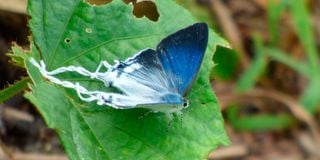Premium
Butterflies in danger of extinction due to climate change

Uganda Hairstreak butterfly at Sunbird Hill Kibale Forest. Some species of butterflies are at risk of going extinct because of shifting rainfall patterns occasioned by climate change.
A recent study carried out in Sri Lanka has established that Miami blue butterfly is at risk of going extinct because of shifting rainfall patterns occasioned by climate change.
The study, which was conducted by a group of researchers at North Carolina State University simulated 20 different climate models to show how this particular species would respond to climate changes.
The researchers established the butterfly population went down when rainfall delayed and the diapause duration (when larvae suspend their development during dry conditions and resume when the wet season comes about) increased.
“We found that shifting rainfall patterns can determine whether the Miami blue butterfly populations grow or shrink, even without any other environmental variables changing. “This is not only concerning for this rare butterfly, but for all insects in precipitation-driven systems. Both the tropics and rainfall patterns have been largely overlooked in the conversation about climate change and animal life cycles,” said Erica Henry, author of the study and a postdoctoral fellow in applied ecology at NC State.
The study also explains that there is uncertainty about how precipitation will change as the planet warms, yet, there exist butterflies in the tropics that are sensitive to shifts in precipitation.
Tropical insect species in areas that are expected to dry under climate change are also expected to see similar impacts on their lifecycles, resulting in possible declines.
“Climate change is happening everywhere. We can get a better handle on what actions may minimize the negative impacts to biodiversity by thinking more broadly about what that change really means in different parts of the globe,” said Henry.
The University of Florida also attributes the decline of the Miami blue butterfly to urbanisation and loss of coastal habitat. They state that currently, the species is one of the most endangered insects, with about 100 members in existence.
Florida Fish and Wildlife Conservation Commission states that habitat fragmentation and group isolation, mortality and invasive species may have also contributed to the reducing the numbers of the blue butterflies.
The invasive plants smothers and kills native plants that are food for larvae, while others grow densely, displacing the native vegetation





